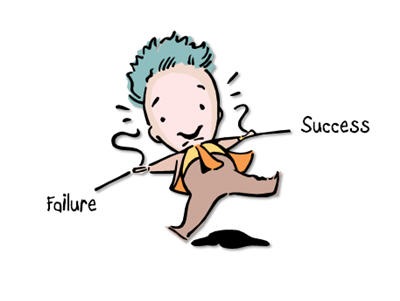Such a lovely post. How beautifully you explain the levels of difficulty that we need to incorporate in learing. I have often observed my kids specially the younger five-year-old daughter, she is experimenting all the time. Much of the learning can be understood if we observe kids at play. The role plays, practice and finally how they rate each other. This if simply mapped to adul learning is the prototype we can safely adhere to. Thanks Tom for such a crystal clear post. My love to your kids.

Did you know that most slot machines have pay-outs greater than 90%? That means that for every dollar you put in, 90 cents gets returned to the player. While those aren’t the best odds, they’re still better than putting your money into Transmeta. Trust me on that one.
Most players don’t mind the risk of losing 10% because they think that there’s a potentially large jackpot in the mix. The reality is that even if you do win 90% of what you put in, you stick it back into the machine and lose 90% of the 90%. This repeats until you have 90% of zero, which my daughter (who is a multiplication pro) tells me is zero. The gambling industry calls this the grind, because they eventually grind you down to become a "loser sausage."
Despite the obvious fact that you’re guaranteed to lose, people still play the slots. The reason is because the machine pays out a little bit here and a little bit there, so you always feel like the big one is just around the corner. However, it rarely is. With its spinning fruit and close calls, the machine conditions us to hang in there even when we’re losing.
The thought of being close to success, but not quite there is a great motivator. Good video games work in a similar manner. They get you to a certain level right before they kill you off. You get close enough to the next level of achievement that it creates an irresistible force to continue. Even though you don’t have the skills or expertise to succeed yet, you’re so close that you’re convinced it’s only a matter of time. So you sit there for hours playing and trying to get to the next level. Eventually your wife gets ticked off and goes out to eat by herself.
Can we create the same type of tension in our learning environments?
One of my favorite learning experiences was during the first week of my Master’s program at Pepperdine University. One of our learning activities was to create Lego Mindstorm vehicles for a competition at the end of the week.
To accomplish the task, we broke into teams and had to deal with interpersonal issues. We also had to learn a simple programming language and figure out the physics of building these robot vehicles. It wasn’t an easy challenge. However it was extremely rewarding and fulfilling. So much so that most of us stayed late to work on the Lego vehicles and also came in early before classes started.
Here are three reasons the Pepperdine challenge worked and how you might be able to apply similar principles to your elearning courses.
Learners Need to Be Challenged

The Lego exercise worked because it really was challenging. None of us were quite sure what to do and how we’d approach it. At the same time, we felt comfortable enough with the Legos that it definitely seemed like something we could accomplish, albeit not easily.
Many times our elearning courses go through a less than engaging sequence of information, where the learner just clicks from one screen to the next. That usually happens because we just quickly convert classroom content for online delivery. And, we do this with little regard to how this information is used by the learner.
Information is good and most likely there’s some value. However, just presenting the information is not the same as learning. Find a way to challenge your learners. What if instead of an information dump, you presented some sort of problem where the learner has to find a solution? Then you provide the information as a resource and let the learners figure it out on their own.
A Safe Learning Environment Makes Room for Success AND Failure

Slot machines and video games work because they create a tension between success and just missing the mark. Design your courses so that the learners are challenged out of their comfort zone, but not so much that they can never move forward. You want them engaged but not frustrated.
We often err on the side of being too easy because of the negative feedback we get from learners at the first sign of the unknown. When I worked for an IT group, I was always amused when people (who were trusted with multimillion dollar IT centers) had problems clicking a next arrow because I didn’t give them an elearning course on clicking next arrows. 🙂
If it’s planned and part of the learning process, there’s nothing wrong with having the learner fail or struggle through the course content. Not knowing is good and critical to real learning. It creates reflective thinking and helps us process our understanding.
The challenge for you is to make it real and engaging so that the learner is lured into the challenge. You also need to find good ways to provide feedback that lets the learner make adjustments and feel successful in the process. Many times the only feedback they get is at the end of the course in an all-or-nothing final assessment.
Curiosity is Critical to Learning

I spend a lot of time watching my children learn. Inevitably a lot of their learning is wrapped around this basic question, "What happens if I do this?" Normally this is OK unless it involves knives and the wood posts in my basement. Put them in front of a computer and they’ll have no qualms about clicking all over the screen to see what happens.
On the other hand, adult learners are a little slower to embrace that type of freedom in learning. As we gain experience, we become more inhibited and less inclined to "click all over the screen." We’ve been conditioned to avoid the risk that leads to discovery.
That’s why the point about having a safe learning environment is critical. If you are going to challenge your learners, they need a safe place to fail. Once you have this, you open the door to discovery. And with that, you can leverage a person’s curiosity.
One of the great values in elearning is that you can create a safe environment. The learner is not restricted to time and place and has freedom to learn without losing face.
Create a problem or opportunity for the learner to play around and test ideas. It doesn’t need to be overly complicated. It can even be something as simple as the way Prometheus used the Engage interactions as mini assessments (slides 11-15). What’s neat about the self assessments is that they’re designed so that regardless of what you initially choose, you can always ask, &
quot;What would have happened had I clicked here?"
You can create engaging elearning courses if you find a way to challenge your learners. The key is to instigate problem-solving, provide feedback, and allow for adjustments. With some forethought, there’s no reason why you can’t apply similar concepts to your next elearning course. Make that your challenge.
I’m interested in your ideas and feedback. Feel free to share them with the community in the comments section.
Events
- Everyday. Check out the weekly training webinars to learn more about Rise, Storyline, and instructional design.
Free E-Learning Resources
 |
 |
 |
|
Want to learn more? Check out these articles and free resources in the community. |
Here’s a great job board for e-learning, instructional design, and training jobs |
Participate in the weekly e-learning challenges to sharpen your skills |
 |
 |
 |
|
Get your free PowerPoint templates and free graphics & stock images. |
Lots of cool e-learning examples to check out and find inspiration. |
Getting Started? This e-learning 101 series and the free e-books will help. |
41 responses to “What Slot Machines, Video Games and Legos Have to do with E-Learning”
Thanks Tom. Great post. It seems so obvious after you read it.
I’ve often found myself wondering what I need to know and what I ‘really’ need to know when I sit in front of a ‘page turning’ elearning exercise. The problem solving, practical challenge can clear that up very quickly.
I agree wholeheartedly with the role of ‘curiosity’ in learning.
Great Post Tom, As a father of a 5 and 3 year old, your points really hit home with me. Lego’s and video games were also my favorite two activities growing up and it is great sharing them with my kids as well as considering their implications as a human resource development manager in my organization today. Lastly, I am not happy to report I just donated 80$ to Harrah’s slot machines that had me “conditioned” in New Orleans last week. THANKS!
Great post, Tom! As a native Las Vegan I am proud to say you have hit upon the key concepts of slot machines…and the importance of addressing different learning modalities in e-learning. Thank you for all of your information, it’s really wonderful!
Thanks Tom, i like this article very much
I have to tell you that I LOVE THESE emails that I get. They contain the best ideas for eLearning. Keep ‘em coming. It is obvious that a lot of thought and research goes in to each one. Thanks
When your emails arrive in my inbox, I’m like a little kid on Christmas morning after Santa just arrived! I get excited and soak up every last sentence! There is always a TON of valuable information in each blog so THANK YOU! At my company, we have a terrible habit of taking content and just sticking it into an online platform. Your tricks and techniques have been incredibly helpful in revitalizing our elearning world! I’m excited to start using the mini-assessments in my next cbt! Thanks again!
Hi Tom,
Great Post! I like the problem solving idea for e-learning. It’s one of my favorites. Otherwise, why create e-learning if there isn’t some level of challenge. Learning is about experiencing new things and being in uncomfortable situations. For some of my courses, I design reflective type activities –to encourage critical thinking. On example used is add a short case study and then an assessment question (What would you do?). Learners can respond to the question based on their thoughts. With this, there is no right or wrong answer –just feedback based on their response. It’s a challenge to design these activities because they must be relative to the job. However, they’ve worked well.
Thank you for your ideas. I’ve learned so much from your Blogs.
Thanks for a great explanation about slot machines. If I remember my college psych class, what’s happening between us and the slots is called intermittent reinforcement. It is very powerful, as most of us probably know, and it’s what all gambling is based on.
As a side note, this is also what’s happening when our pets follow us into the kitchen thinking they’ll get food. Sometimes they do and sometimes they don’t, but they are always there just in case. Just as sometimes we get a few quarters back from the slot machine and sometimes we don’t. But, there we are.
Thank you Tom for great ideas for e-learning. All of your blogs are very helpful.
Great post. The challenge for me is when creating the “wrong answers” for the exercise. I mostly build system related courses and really stuggle with coming up with incorrect answers that are effective. They usually end up being too easy and obvious.
Hi Tom! I am creating an e-learning game and your suggestions are exactly what I was searching. Thanks!
Hey Mark, one thing to try is to get an idea of what mistakes are commonly made during a particular process. Then compile them and use them as the “distractors” for the wrong answers. The mistakes don’t even necessarily have to relate directly to the step you are on–they could be from previous or upcoming steps in the process.
Would that work for you?
Great post, Tom. One of my current projects requires that certain auto insurance adjusters be able to assess the documents they receive (photos & spec sheets, among others) and determine if the suspension system of a vehicle is likely to have been damaged. The process involves a pretty high level of judgment and critical thinking to complete it correctly. We decided to present examples of the documents at or very near the outset and allow them to demonstrate their ability to properly use them by asking question about the information shown in the documents. Those who know how to obtain the information are fast-tracked past that portion of the presentation because they don’t need it – they already know it and have demonstrated that they know it. Presented at each step, this method does two things for us.
First, individuals who already know an ability to complete it in a very short time – no needless waste of their time or energy. Second, completion of the course by implication shows they have the knowledge and skills to perform the job and have done it successfully – sort of a built-in Level two assessment.
All of that by way of saying that I thought it an amazing coincidence the just yesterday my team was discussing the challenge element, and today your e-mail, dealing with the exact same concept, shows up in my in-box.
Keep ’em coming, and keep up the good work!
Thanks again for your weekly emails. They are truly inspirational.
I have watched the Prometheus ergonomics demo many times but just today noticed how they used the labeled graphic for the quiz question. We have been doing something similar with the tab interaction. Use the introduction to deliver a simple scenario and then 3 or 4 tabs that are plausible answers that explain why the best answer is the best. The labeled graphic gives some great flexibility that had not occurred to me before.
Keep challenging us to develop high quality e-learning and to allow self-direction for our learners.
GF
What if it were possible to create an e-learning tool that was like a multi-player role playing environment (think Second Life) with built-in challenges that require people to work together (or independently) to solve problems and learn new information?
The “game” could have a time limit to spur the learners to keep moving through, or rewards at various steps along the way to keep people motivated to finish the course.
It would be really cool to be able change the environment to suit the course. For instance, if you were training fire-fighters, your environment might be in a building that is on fire. Training human resources employees might take a little more creativity…
If someone were to create a tool that allowed companies to design e-learning courses like this, the courses would be a lot more fun and engaging for the learners, and could possibly encourage better retention of the information. I think it could be a big seller.
Thanks Tom, good learning experience from your e-learning posts. What was missing was the challenge to your learners.
Only last week we had a little argument that what should go in as content for such problems? How challenging should they be? On one side you would like to retain the interest of your learner, so that he does not quit half-way, and on the other you would like him to solve problems. Where lies the line dividing the two scenarios?
GREAT STUFF! Your blog and all the comments provided from the ‘blog community’ as been great. Keep it coming.
Excellent post, Tom!
An elearning should be challenging enough to the level of understanding of your audience. If every elearning professionals could apply this, learners will definitely have a great learning experience.
Tom this is a great post. I agree with what you said on how children learn with the basic question “What happens when I do this?”(sans the knives and wood posts) the curiosity level is higher in children when they play and are not afraid to find the answers they seek. On the adult level it is different because is it human nature when one does not want to appear “dumb” or “stupid” if they get the wrong answer and restricts the learning process. You are right when you said that we need to create a “safe place to fail” for the adult learners and enticed them to learn more instead of inhibiting them. “[C]reating the safe environment gives the learner the freedom to learn without losing face without restricting them to time and place.”
Looking forward to your next blog.
Cheers!
Hello Sir!
I´m starting my own blog about elearning and I was seeking “recomended www-links” when I notice this blog.
As a lifelong friend of videogames and elearning (even sometimes people say, “how you can so called elearning-specialist when you are so critical towards many elearning-practises”) , your last article really caught my eye – positively! You are absolutely right about your three thesis. We have to challenge ours students and let them try. Too much information (instantly) and too easy tasks (within you can´t progress/develop) without good feedback just don´t work. Developers of games like Zelda-, Metroid- Final Fantasy or GTA -series know all this.
This link between videogames and (e)learning is very interesting, and it would be interesting to read more comments and information about it.
I was lucky enough to be invited to meet up with Lego at Bradford University.
Lego wanted to know what we (as in a school IT dept) wanted from Lego online.
I roughed up a problem-solving scenario which looks a bit like this!
http://www.lego.com/eng/create/activities/worldbuilder/default.asp?x=x
Way to go!!
Not too much challenge, not too little. Like Goldilocks and the Three Bears. You’ve really helped me see something important with this post, Tom.
Safety in the learning environment can be deadly boring. But too much challenge creates tension that defeats the learner, too.
Thanks for this distinction. Experiential learning brings these issues to the foreground faster than elearning and they’re just as essential online.
I’m participating in a new social elearning platform called LearnHub (www.learnhub.com) and noticing that the environment there allows for a lot of experimentation with how much challenge is enough. Check it out.
I’m a newbie at e-learning and I’ve already learned so much from you. I spent years doing live training and getting by on my hands on experience and sense of humor. I’ve learned that e-learning is so completely different from standing up there live.
My question to you if where you get the excellent pictures and graphics you use in your samples. I really like the illustrations you used in your branching scenarios as well as the photos. Can you give me some good sources to use for this?
[…] the sector on enhancing vocational education and training provider capability and the second from Tom Kuhlmann on Lego, Slots and Video Games where he basically outlined with really cool images everything that […]
TOM,
The concept of leaners needs to be challenged is fine and i also accept that. But how practically this can be implemented in all courses. Will all the learners show their interest to explore and accept the challenge.
Say for example i prepared a course recently to explain about a process which is internal to my company. Though many of our associates not aware of those proccess they are not interested to read the course. Frankly speaking they are interested even to open the course. In such cases Will that the above said learning is useful?
Thanks Tom, I have been conducting training for teachers and the info about the adult learners and safe learning environment is really great! Will definitely keep that in mind.
But i do have senior teachers who aren’t that IT savvy. Well, will keep trying.
[…] utilizzi politici e sociali.” In qualche modo poi lo stesso tema è ritornato anche in un recente post sul blog di Articulate che descrive come alcune logiche proprie dei videogames possano essere […]
I loved your blog. It was of great help. I have a question Tom.
How do i remove the shadow from a customized button (created in flash) from a published captivate file? It’s displaying a black box behind the button. It’s not there in the raw file but when i publish it, there’s this black box the size of the canvas of the button. I can’t seem to get rid of it! Please help.
Ok. Thanks Tom. I appreciate the response.
@Diana: The shadow on the customized button is due to the transparency in the image. If you would like some help with fixing this please message me via mfubib |at| gmail |dot| com
@Tom: You have some incredible ideas about elearning and I have found reading your blog to always be very inspirational. I have been developing elearning material for the past year and have learnt so much during that time.
I am now beginning to experiment with rapid development and deployment of engaging content in an @home call center environment – thanks again.
Tom, I couldn’t agree more. Boring training whether by class or eLearning is a choice made by the trainer or designer. I believe whole-heartedly that all learning must have a practical application and if you can make it fun and meaningful, why not!
@Chuck: You don’t need special programmes to do this. One Canadian company uses a ‘Race Around the World’ scenario. Staff are given a set of tasks: eg. they have to find the names of the company founders, find out what year the company was founded etc, then enter this info at the start of the next module to ‘unlock’ it. Periodically, they would unlock little gifts – like a free coffee at the canteen or a company pin.
There was also a UK trial using games as part of the eLearning content for nurses. The nurses had to do various particular virtual tasks – but as in real life, they would keep getting interrupted by virtual patients and virtual family members and the challenge was to complete the task in the correct order within a certain timeframe. I believe that was done on Captivate. The results were that these nurses did better on their final assessments than those who were completing more traditional ‘click & flick’ eLearns.
Nice article… I am often teetering between making it a hand-holding session or assuming too much. The key, like you say – is challenging just a little – so learners feel like they’re accomplishing something – and moving forward putting concepts into use as they learn them.
I’m getting ready to do a large elearning course. I’ve found your help very valuable and eventually I’ll be able to afford the articulate software! lol.
Love this Articulate program it seem easy , Nice post .But how much thsi program cost? I prefer to have it and work with it very slow. It the way I like to learn .Know ever part well.
Thank you
Love this Articulate program it seem easy , Nice post .But how much this program cost? I prefer to have it and work with it very slow. It the way I like to learn .Know ever part well.
Thank you
[…] also talked about slot games, jeopardy and tic-tac-toe in elearning. A gaming mindset definitely challenges the brain, but a whiz-bang game to just dress up a course and make it engaging isn’t really a great […]
Interesting article. i liked it very much
Innovative and original, with several useful combinations for success. I would recommend creating a minifig in your likeness.









0
comments